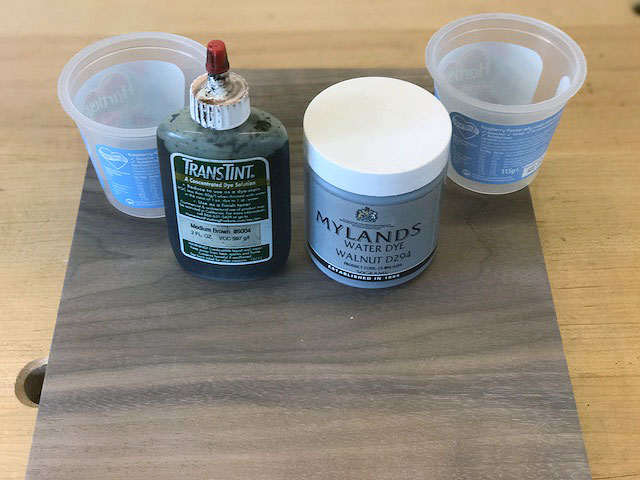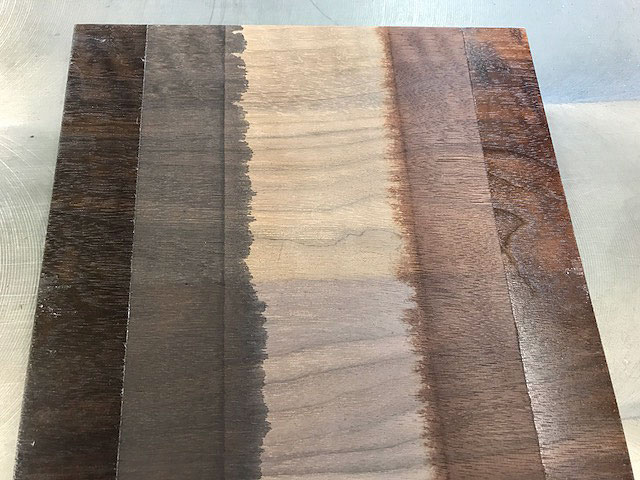custard
Established Member
There was a thread recently about dealing with the sapwood that you regularly encounter when working with Walnut. My general approach (and the one widely used by most other furniture makers) is that you apply a wash coat of a regular aniline dye to the entire piece and then build up the colour specifically in the area of the sapwood. You can get aniline dyes as water based or spirit based. The spirit based ones claim to be more lightfast, but after using these products for over thirty years I've never found much difference in lightfastness between them, the truth is all aniline dyes are pretty poor in this respect. The main difference is that spirit based doesn't raise the grain and dries within seconds. I always say that unless you're an experienced finisher you should stick to water based, which maintains that critical "wet edge" throughout the job and therefore makes blending in much easier.
Looked at more broadly this general technique is the backbone of so many finishing tasks; matching in sapwood, patching in new timber with antique restoration, blending in colour variations across a complete piece of furniture, adding some pop or warmth to timber, reviving faded wood; they're all finishing tasks that are generally based around using aniline dyes.
But the big shortcoming of aniline is that it fades in sunlight. Pigment colour doesn't fade nearly as much, but it's difficult to use (especially on open grained timbers where it pools in the pores and just looks really nasty), and it obscures the grain and dulls the life and vitality of timber. The fact is pigmented stains are halfway to being paint, so their relevance to fine hardwood furniture is pretty limited.
I was interested when Marcros flagged up a relatively new alternative dye called Transtint that he'd picked up in the US. It has a radically different chemistry and claims to be significantly more lightfast while still fully dissolving (as opposed to being in suspension like pigment). He very kindly sent me some samples to test and I promised I'd post the results. So here it is, thank you Marcros!

I used an offcut of Black Walnut and mixed up some Transtint Medium Brown and some Mylands Walnut Stain according to the manufacturers instructions. I didn't have two directly comparable colours to test, but Transtint do offer a "Dark Walnut" and a "Mission Brown" which are both cool toned and would be very suitable with Walnut. In terms of ease of mixing up there's not much in it, I use powdered aniline dye but Transtint is a liquid, it doesn't really make any odds.

Transtint is on the left in this photo, bare timber is in the centre, and the aniline dye is on the right. The outside strips of both edges have had a couple of coats of Satin Osmo.
It's difficult to tell from a rubbish phone photo, but there does seem to be a small added brightness and clarity to the Transtint product, it tends to bleed a bit less too. But both products are fairly equal in terms of their ability to convincingly blend in sap (again hard to see in the photo, but the sap bands were fairly distinct in real life). I separately tried mixing different shades of Transtint dye and it's excellent, showing no tendency to separate out or "rainbow".
There's some more technical advice on Transtint here,
http://www.joewoodworker.com/transtints.htm
Like aniline dye it seems to be widely compatible as a stain used under another finish, but it also appears to have some restrictions when used as a colouring component within other finishes. That's not too big a problem, unless you're a professional finisher or using it for a specialised finishing technique like those sometimes encountered in luthier work, then you're unlikely to want to incorporate a dye within another finish.
The thing that most interests me however is Transtints claims for significantly enhanced lightfastness. So I'll mask off the bottom half of this test board and put it in a south facing window for a few months and see what happens. If it really can deliver in terms of fade resistance then I'll certainly test further with a view to switching over completely. I can't find a UK stockist but it's available from US retailers like StuMac and Rockler who are both pretty slick with international orders.
Looked at more broadly this general technique is the backbone of so many finishing tasks; matching in sapwood, patching in new timber with antique restoration, blending in colour variations across a complete piece of furniture, adding some pop or warmth to timber, reviving faded wood; they're all finishing tasks that are generally based around using aniline dyes.
But the big shortcoming of aniline is that it fades in sunlight. Pigment colour doesn't fade nearly as much, but it's difficult to use (especially on open grained timbers where it pools in the pores and just looks really nasty), and it obscures the grain and dulls the life and vitality of timber. The fact is pigmented stains are halfway to being paint, so their relevance to fine hardwood furniture is pretty limited.
I was interested when Marcros flagged up a relatively new alternative dye called Transtint that he'd picked up in the US. It has a radically different chemistry and claims to be significantly more lightfast while still fully dissolving (as opposed to being in suspension like pigment). He very kindly sent me some samples to test and I promised I'd post the results. So here it is, thank you Marcros!

I used an offcut of Black Walnut and mixed up some Transtint Medium Brown and some Mylands Walnut Stain according to the manufacturers instructions. I didn't have two directly comparable colours to test, but Transtint do offer a "Dark Walnut" and a "Mission Brown" which are both cool toned and would be very suitable with Walnut. In terms of ease of mixing up there's not much in it, I use powdered aniline dye but Transtint is a liquid, it doesn't really make any odds.

Transtint is on the left in this photo, bare timber is in the centre, and the aniline dye is on the right. The outside strips of both edges have had a couple of coats of Satin Osmo.
It's difficult to tell from a rubbish phone photo, but there does seem to be a small added brightness and clarity to the Transtint product, it tends to bleed a bit less too. But both products are fairly equal in terms of their ability to convincingly blend in sap (again hard to see in the photo, but the sap bands were fairly distinct in real life). I separately tried mixing different shades of Transtint dye and it's excellent, showing no tendency to separate out or "rainbow".
There's some more technical advice on Transtint here,
http://www.joewoodworker.com/transtints.htm
Like aniline dye it seems to be widely compatible as a stain used under another finish, but it also appears to have some restrictions when used as a colouring component within other finishes. That's not too big a problem, unless you're a professional finisher or using it for a specialised finishing technique like those sometimes encountered in luthier work, then you're unlikely to want to incorporate a dye within another finish.
The thing that most interests me however is Transtints claims for significantly enhanced lightfastness. So I'll mask off the bottom half of this test board and put it in a south facing window for a few months and see what happens. If it really can deliver in terms of fade resistance then I'll certainly test further with a view to switching over completely. I can't find a UK stockist but it's available from US retailers like StuMac and Rockler who are both pretty slick with international orders.










